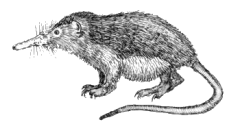
Venomous mammals are tetrapods of the class Mammalia that produce venom, which they use to kill or disable prey, to defend themselves from predators or conspecifics or in agonistic encounters. Mammalian venoms form a heterogeneous group with different compositions and modes of action, from four orders of mammals: Eulipotyphla, Monotremata, Primates, and Chiroptera. To explain the rarity of venom delivery in Mammalia, Mark Dufton of the University of Strathclyde has suggested that modern mammalian predators do not need venom because they are able to kill quickly with their teeth or claws, whereas venom, no matter how sophisticated, requires time to disable prey.[1]
In spite of the rarity of venom among extant mammals, venom may be an ancestral feature among mammals, as venomous spurs akin to those of the modern platypus are found in most non-therian Mammaliaformes groups.[2]
Venom is much more common among other vertebrates; there are many more species of venomous reptiles (e.g. venomous snakes) and fish (e.g. stonefish). Some birds are poisonous to eat or touch (e.g. hooded pitohui) though no bird species is known to be venomous.[3] There are only a few species of venomous amphibians; certain salamandrid salamanders can extrude sharp venom-tipped ribs.[4][5]
- ^ Dufton, Mark (1992). "Venomous mammals". Pharmacology and Therapeutics. 53 (2): 199–215. doi:10.1016/0163-7258(92)90009-o. PMID 1641406.
- ^ Jørn H. Hurum, Zhe-Xi Luo, and Zofia Kielan-Jaworowska, Were mammals originally venomous?, Acta Palaeontologica Polonica 51 (1), 2006: 1-11
- ^ Gong, Enpu; Larry B Martin; David A Burnham; Amanda R Falk (12 January 2010). "The birdlike raptor Sinornithosaurus was venomous". Proc. Natl. Acad. Sci. USA. 107 (2): 766–768. Bibcode:2010PNAS..107..766G. doi:10.1073/pnas.0912360107. PMC 2818910. PMID 20080749.
- ^ "Venomous Amphibians (Page 1) - Reptiles (Including Dinosaurs) and Amphibians - Ask a Biologist Q&A". Askabiologist.org.uk. Retrieved 2010-07-28.
- ^ Robert T. Nowak & Edmund D. Brodie Jr. (1978). "Rib penetration and associated antipredator adaptations in the salamander Pleurodeles waltl (Salamandridae)". Copeia. 1978 (3): 424–429. doi:10.2307/1443606. JSTOR 1443606.